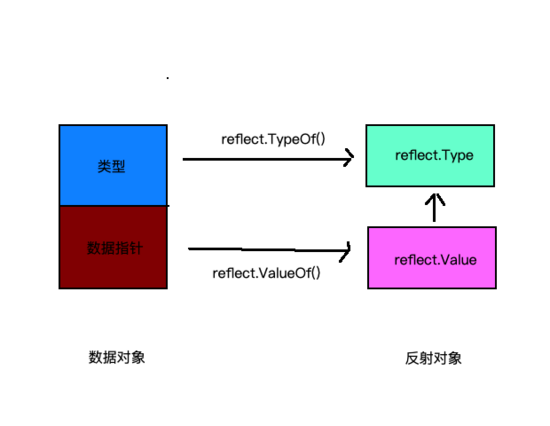Go反射的實現(xiàn)和 interface 和 unsafe.Pointer 密切相關(guān)。如果對golang的 interface 底層實現(xiàn)還沒有理解����,可以去看我之前的文章: Go語言interface底層實現(xiàn) , unsafe.Pointer 會在后續(xù)的文章中做介紹����。
(本文目前使用的Go環(huán)境是Go 1.12.9)
interface回顧
首先我們簡單的回顧一下interface的結(jié)構(gòu),總體上是:

細分下來分為有函數(shù)的 iface 和無函數(shù)的 eface (就是 interface{} );
無函數(shù)的 eface

有函數(shù)的 iface

靜態(tài)類型(static interface type)和動態(tài)混合類型(dynamic concrete type)
Go語言中�����,每個變量都有唯一個 靜態(tài)類型 �����,這個類型是編譯階段就可以確定的���。有的變量可能除了靜態(tài)類型之外��,還會有 動態(tài)混合類型 ��。
例如以下例子:
//帶函數(shù)的interface
var r io.Reader
tty, err := os.OpenFile("/dev/tty", os.O_RDWR, 0)
if err != nil {
return nil, err
}
r = tty
//不帶函數(shù)的interface
var empty interface{}
empty = tty
有函數(shù)的 iface 的例子
我們一句一句來看:第1行�����, var r io.Reader

第4行至第七行就是簡單的賦值��,得到一個 *os.File 的實例,暫且不看了��。最后一句第十句 r = tty

無函數(shù)的 eface 的例子
我們接著往下看����, var empty interface{}

最后是 empty = tty

但是記?����。弘m然有 動態(tài)混合類型 �����,但是對外”表現(xiàn)”依然是靜態(tài)類型���。
Go反射簡介
Go反射有三大法則:
//接口數(shù)據(jù) =====》 反射對象
1. Reflection goes from interface value to reflection object.
//反射對象 ===> 接口數(shù)據(jù)
2. Reflection goes from reflection object to interface value.
// 倘若數(shù)據(jù)可更改�,可通過反射對象來修改它
3. To modify a reflection object, the value must be settable.
Go 的反射就是對以上三項法則的實現(xiàn)���。
Go的反射主要由兩部分組成: Type 和 Value �, Type 和 Value 是倆結(jié)構(gòu)體:(這倆結(jié)構(gòu)體具體內(nèi)容可以略過不看,知道有這回事兒就行了)
Type:
type Type interface {
Align() int
FieldAlign() int
Method(int) Method
MethodByName(string) (Method, bool)
NumMethod() int
Name() string
PkgPath() string
Size() uintptr
String() string
Kind() Kind
Implements(u Type) bool
AssignableTo(u Type) bool
ConvertibleTo(u Type) bool
Comparable() bool
Bits() int
ChanDir() ChanDir
IsVariadic() bool
Elem() Type
Field(i int) StructField
FieldByIndex(index []int) StructField
FieldByName(name string) (StructField, bool)
FieldByNameFunc(match func(string) bool) (StructField, bool)
In(i int) Type
Key() Type
Len() int
NumField() int
NumIn() int
NumOut() int
Out(i int) Type
common() *rtype
uncommon() *uncommonType
}
Value:
type Value struct {
typ *rtype
ptr unsafe.Pointer
flag
}
你會發(fā)現(xiàn)反射的實現(xiàn)和interface的組成很相似�����,都是由“類型”和“數(shù)據(jù)值”構(gòu)成�����,但是值得注意的是:interface的“類型”和“數(shù)據(jù)值”是在“一起的”��,而反射的“類型”和“數(shù)據(jù)值”是分開的�。
Type 和 Value 提供了非常多的方法:例如獲取對象的屬性列表、獲取和修改某個屬性的值����、對象所屬結(jié)構(gòu)體的名字、對象的底層類型(underlying type)等等
Go中的反射����,在使用中最核心的就兩個函數(shù):
- reflect.TypeOf(x)
- reflect.ValueOf(x)
這兩個函數(shù)可以分別將給定的數(shù)據(jù)對象轉(zhuǎn)化為以上的 Type 和 Value 。這兩個都叫做 反射對象
Reflection goes from interface value to reflection object(法則一)
給定一個數(shù)據(jù)對象�����,可以將數(shù)據(jù)對象轉(zhuǎn)化為反射對象 Type 和 Value 。

事例代碼:
package main
import (
"fmt"
"reflect"
)
func main() {
var x float64 = 3.4
t := reflect.TypeOf(x)
v := reflect.ValueOf(x)
fmt.Println("type:", t) //type: float64
fmt.Println("value:", v.String()) //value: float64 Value>
fmt.Println("type:", v.Type()) // type: float64
fmt.Println("kind is float64:", v.Kind() == reflect.Float64) //kind is float64: true
fmt.Println("value:", v.Float()) //value: 3.4
}
由代碼17行可以看出: Value 還可以獲取到當前數(shù)據(jù)值的 Type �。
所以,法則一的圖應(yīng)為:

Reflection goes from reflection object to interface value.(法則二)
給定的反射對象���,可以轉(zhuǎn)化為某種類型的數(shù)據(jù)對象�����。即法則一的逆向。

注意 Type 是沒法逆向轉(zhuǎn)換的�����,仔細想想也合理�����,如果可逆類型轉(zhuǎn)化成什么呢�����?(#^.^#)
承接法則一的代碼:
package main
import (
"fmt"
"reflect"
)
func main() {
var x float64 = 3.4
t := reflect.TypeOf(x)
v := reflect.ValueOf(x)
...
o := v.Interface().(float64) // 法則2代碼
fmt.Println(o)
}
To modify a reflection object, the value must be settable.(法則三)
法則三是說:通過反射對象����,可以修改原數(shù)據(jù)中的內(nèi)容�。
這里說的反射對象�,是指 Value ,畢竟 Type 只是表示原數(shù)據(jù)的類型相關(guān)的內(nèi)容��,而 Value 是對應(yīng)著原數(shù)據(jù)對象本身�。
在目前以上的所有例子中,反射得到的 Value 對象的修改�,都是無法直接修改原數(shù)據(jù)對象的。
package main
import (
"fmt"
"reflect"
)
func main() {
var x float64 = 3.4
t := reflect.TypeOf(x)
v := reflect.ValueOf(x)
....
o := v.Interface().(float64)
fmt.Println(o)
v.SetFloat(5.4) //此行會報錯
fmt.Println(x)
}
這段代碼20行會報一個panic
reflect: reflect.Value.SetFloat using unaddressable value
這句話的意思并不是地址不可達�����,而是:對象 v 不可設(shè)置( settable )�。
我們可以通過 Value 結(jié)構(gòu)體的 CanSet() 方法來查看是否可以設(shè)置修改新值。
通過以下代碼可以知道 CanSet() 返回值是false��。
fmt.Println(v.CanSet()) // false
如何通過反射對象來修改原數(shù)據(jù)對象的值呢��?
如何才能可以通過反射對象來修改原數(shù)據(jù)對象的值或者說為什么不能設(shè)置呢����?
原因簡單且純粹:在Go中,任何函數(shù)的參數(shù)都是值的拷貝��,而非原數(shù)據(jù)。
反射函數(shù) reflect.ValueOf() 也不例外��。我們目前得到的反射對象�,都是原對象的copy的反射對象,而非原對象本身����,所以不可以修改到原對象;即使可以修改����,修改一個傳參時候的副本,也毫無意義�����,不如報錯兒�����。Go反射第三法則中的制定的 settable 屬性就由此而來�,還延伸出了類似于 CanSet() 的方法�。
那如何修改呢?
首先���,在Go中要想讓函數(shù)“有副作用“�,傳值必須傳指針類型的。
...
var x float64 = 3.4
v := reflect.ValueOf(x)
...
此時還不行����,因為這樣反射對象對應(yīng)的是原數(shù)據(jù)對象的指針類型,必須要拿到當前類型的值類型(*v)��,如何做���?
Go提供了另外一個方法 Elem()
...
var x float64 = 3.4
v := reflect.ValueOf(x)
p := v.Elem()
fmt.Println(p.CanSet()) // true
p.SetFloat(7.1)
fmt.Println(x) // 7.1
看以上代碼��,就可以修改原數(shù)據(jù)了�����。
反射原理
不難發(fā)現(xiàn)���,go的反射和interface在結(jié)構(gòu)上是如此的相近!都分為兩部分:一部分是 Type 一部分是 value ����。
反射會不會是比著interface來實現(xiàn)的?
反射是什么意思�?反射的意思是在運行時����,能夠動態(tài)知道給定數(shù)據(jù)對象的類型和結(jié)構(gòu)���,并有機會修改它����!
現(xiàn)在一個數(shù)據(jù)對象�����,如何判斷它是什么結(jié)構(gòu)�����?
數(shù)據(jù)interface中保存有結(jié)構(gòu)數(shù)據(jù)呀�����,只要想辦法拿到該數(shù)據(jù)對應(yīng)的內(nèi)存地址�,然后把該數(shù)據(jù)轉(zhuǎn)成interface�����,通過查看interface中的類型結(jié)構(gòu),就可以知道該數(shù)據(jù)的結(jié)構(gòu)了呀~
其實以上就是Go反射通俗的原理���。
圖可以展示為:

圖中結(jié)構(gòu)中牽扯到的指針����,都是 unsafe.Pointer 指針�,具體這是個什么指針,后續(xù)的文章中會有介紹�����,在此���,你就姑且認為是可以指向Go系統(tǒng)中任意數(shù)據(jù)的指針就可以���。
源碼部分 (以下部分可以忽略,是我在查閱代碼時候遇到的一點點坑���。)
我們來看看具體的源碼:源碼在”GO SDK/src/refelct“包中��,具體主要是包中的”type.go”和”value.go”這兩個文件�。
可以簡單的認為�,反射的核心代碼�,主要是 reflect.ValueOf() 和 reflect.TypeOf() 這兩個函數(shù)�����。
先看類型轉(zhuǎn)換: reflect.TypeOf()
// TypeOf returns the reflection Type that represents the dynamic type of i.
// If i is a nil interface value, TypeOf returns nil.
func TypeOf(i interface{}) Type {
eface := *(*emptyInterface)(unsafe.Pointer(i))
return toType(eface.typ)
}
其中出現(xiàn)了兩種數(shù)據(jù)結(jié)構(gòu)��,一個是 Type �����,一個是 emptyInterface
分別看看這兩者的代碼:
emptyInterface 在 ”GO SDK/src/reflect/value.go“文件中
// emptyInterface is the header for an interface{} value.
type emptyInterface struct {
typ *rtype
word unsafe.Pointer
}
// nonEmptyInterface is the header for an interface value with methods.
type nonEmptyInterface struct {
// see ../runtime/iface.go:/Itab
itab *struct {
ityp *rtype // static interface type
typ *rtype // dynamic concrete type
hash uint32 // copy of typ.hash
_ [4]byte
fun [100000]unsafe.Pointer // method table
}
word unsafe.Pointer
}
仔細一看�,是空接口和包含方法的interface的兩個結(jié)構(gòu)體。且和 eface 和 iface 內(nèi)容字段一致���!不是有 eface 和 iface 了嗎��?這兩者有什么不同�����?����?
經(jīng)過查閱代碼�,發(fā)現(xiàn):
interface源碼(位于”Go SDK/src/runtime/runtime2.go“)中的 eface 和 iface 會和 反射源碼(位于”GO SDK/src/reflect/value.go“)中的 emptyInterface 和 nonEmptyInterface 保持數(shù)據(jù)同步!
總結(jié)
以上所述是小編給大家介紹的圖文詳解go語言反射實現(xiàn)原理���,希望對大家有所幫助�!
您可能感興趣的文章:- golang之反射和斷言的具體使用
- 詳解Golang利用反射reflect動態(tài)調(diào)用方法
- 淺談Go語言中的結(jié)構(gòu)體struct & 接口Interface & 反射
- Go語言學(xué)習(xí)筆記之反射用法詳解
- Go語言中反射的正確使用
- 談?wù)凣o語言的反射三定律
- go語言通過反射獲取和設(shè)置結(jié)構(gòu)體字段值的方法
- Go語言中使用反射的方法